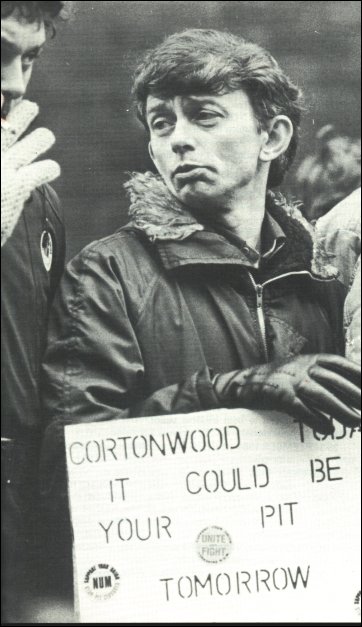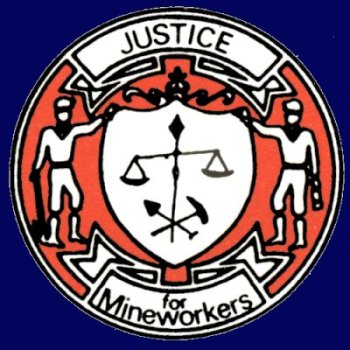| Strike
Chronology THE
EVENTS leading to the overtime ban in November 1983 and the subsequent miners'
strike for jobs in 1984-85. Before
the Strike
27 SEPTEMBER 1983 – NUM submits annual pay claim.
29 SEPTEMBER 1983 – NCB gives written negative reply to the Union's
claim, adding that before their offer of a 5.2 % could be accepted: "first
over-production of high cost capacity must be eliminated".
21 OCTOBER
1983 – NUM Special Delegate Conference unanimously agreed:
(1) to
reject the Board's wage proposals as total unsatisfactory;
(2) to reaffirm
the Union's opposition to pit closures other than on grounds of exhaustion and
to fight any further reduction in manpower levels and to resist NCB and Government
plans to close 70 pits over the coming five year period;
(3) to impose a full
overtime ban from 31st October.
27 OCTOBER 1983 – NCB reaffirms
their demands.
31 OCTOBER 1983 – Overtime ban started.
1 MARCH 1984 NCB – announces the closure of Cortonwood Colliery in Yorkshire
and announce a cut back of 4 million tonnes of coal in the forthcoming year with
a loss of 20,000 jobs.
The Strike
5 MARCH 1984 –
Strike starts in Yorkshire in protest, following an overwhelming mandate for a
ballot vote to take industrial action to protect jobs and mining communities.
6 MARCH 1984 – Scottish and Yorkshire Areas of the NUM call strike action.
By 12th March half of the miners on strike nationally.
14 MARCH 1984
– The National Reporting Centre, at the request of the Nottingham Police
drafts 8,000 police officers into the county from half of the 43 forces in Britain.
Court rules that Yorkshire NUM must withdraw flying pickets.
15 MARCH
1984 – David Jones, miner aged 23, killed whilst picketing in Ollerton, Notts.
18 MARCH 1984 – Kent miners stopped by police and turned hack at the
Dartford Tunnel. Police occupy army camps in Nottinghamshire.
19 MARCH
1984 – Yorkshire NUM arising from litigation under Tory anti-trade union
legislation found to be in contempt of court (postponed indefinitely). NUM members
picket 27 Notts pits and peacefully persuade their colleagues to join the strike
action. Police decide to blockade the county of Nottinghamshire.
26 MARCH
1984 – Lancashire NUM joins strike. NUM President Arthur Scargill appears
in High Court fighting to ensure investment of NUM pension funds in Britain.
28 MARCH 1984 – Yorkshire miners block a section of the Ml motorway.
29 MARCH 1984 – Transport unions impose ban on the movement of coal,
partially successfully. Nurses join the picket lines in South Wales.
3-9 APRIL 1984 – Food kitchens open in every coalfield.
10 APRIL
1984- Emergency debate in the House of Commons on the role of the police in the
strike.
11 APRIL 1984 – Pit Deputies vote to join strike.
19 APRIL 1984 – NUM Special Conference ratifies strike action in the Areas
and calls on all miners to rally to the defence of their industry.
20
APRIL 1984 – Notts and Midlands NUM decide to join strike.
26 APRIL
1984 – High Court says 'No' to NUM policy on investment of pension funds
in Britain.
2 MAY 1984 – CEGB figures show more oil being used to
counterbalance coal shortage.
4 MAY 1984 – Didcot and Aberthaw power
stations shut down.
17 MAY 1984- Leon Brittan admits in Parliament plain
clothes police operating in Notts coalfield.
23 MAY 1984 – NCR walks
out of talks with NUM and demand pledge of union co-operation in the closing of
'uneconomic pits'.
25 MAY 1984 – Full-scale picketing at the Orgreave
coke works. Nottinghamshire scab miners obtain a court order which allows them
to continue working, but which declares that those on strike were striking officially.
29 MAY 1984 – Approximately 2,000 police use riot gear, horses and baton
charges to take coke lorries through picket lines into Orgreave, even though coke
workers join picket line.
30 MAY 1984 – Major confrontations at
the Orgreave picket. 82 arrests including Arthur Scargill. 62 injured.
31 MAY 1984 – Approximately 3,200 police in riot gear at Orgreave from 13
area police forces force major confrontation with unarmed strikers.
31
MAY 1984 – Further conflict at Orgreave. 19 arrests, 20 people injured including
5 police officers.
7 JUNE 1984 – Commons debate on the miners strike.
Thousands march to lobby Parliament. 100 arrests.
8-13 JUNE 1984 –
Talks with NCR, which again result in demands on NUM to agree to management strategy.
15 JUNE 1984 – Joe Green, miner, crushed to death on picket duty at
Ferry Bridge.
18 JUNE 1984 – The battle of Orgreave, where police
run amok. 93 arrests, many miners injured including Arthur Scargill.
27 JUNE 1984 – Over 50,000 people march in support of the NUM. NCR announces
switch of movement of coal from rail to road.
1 JULY 1984 – Leon
Brittan endorses use of Criminal Law rather than Civil Law against the miners.
5 JULY 1984 – NCB/NUM talks, agreed to talk again.
6 JULY 1984-
NCR management visits NUM members at home encouraging them back to work.
8 JULY 1984 – High Court declares NUM Annual Conference unlawful. National
dock strike called against the movement of coal.
13 JULY 1984 –
Government withholds tax refunds to striking miners.
19 JULY 1984 NUM/NCB
talks last 3 days. Despite NUM willingness to negotiate, the NCB are ordered to
stand firm.
31 JULY 1984 – South Wales NUM fined £50,000 under
Tory anti-trade union legislation on picketing.
8 AUGUST 1984 –
Trades Unions press for a 50p a week levy in support of NUM. MacGregor writes
to all striking miners urging a return to work.
11 AUGUST 1984 –
Petition handed to the Queen on the plight of striking miners and their families.
13 AUGUST 1984 – Police refuse to cooperate with the National Council
for Civil Liberties regarding policing of the strike.
16 AUGUST 1984
– South Wales NUM found in contempt of court for refusing to pay fine in
line with TUC Wembley Conference policy. £770,000 of their funds seized.
NCB warns of large job losses in mining due to pits deteriorating.
23
AUGUST 1984 – MacGregor offers working miners 5.2% increase if they agree
to work overtime.
24 AUGUST 1984 – Second dock strike called following
the unloading of coal at Hunterstone.
3 SEPTEMBER 1984 – TUC pledges
support for the NUM.
12 SEPTEMBER 1984 – TUC attempts to organise
talks between the NUM and the NCB. NACODS ballot to strike over instructions to
cross picket lines.
18 SEPTEMBER 1984 – Three-week dock strike called
off.
26 SEPTEMBER 1984 – NCB offers NACODS compromise package.
28 SEPTEMBER 1984 – High Court rules that NUM cannot be forced to hold
national ballot. NACODS ballot result announced – 82.5% majority for strike.
29 SEPTEMBER 1984 – NCB/NUM agree to hold separate exploratory talks.
1 OCTOBER 1984 – Overwhelming support for the NUM at the Labour Party
Conference, whilst NUM/NACODS meet NCB. President served with a High Court writ
whilst sitting in the NUM delegation. The NEC of the NUM reaffirm that the strike
action was official despite court decision.
2 OCTOBER 1984 – NUR/ASLEF
members sent home for refusing to move coal.
4 OCTOBER 1984 – Despite
NUM lawyers arguing that the case should go to a full trial the High Court gives
NUM 5 days to obey the interlocutory injunction and to call the strike off.
8 OCTOBER 1984 – NUM/NCB agree to meet at ACAS under independent Chair
on 11 October.
10 OCTOBER 1984 – NUM fined £200,000 and found
in contempt of High Court.
11 OCTOBER 1984 – ACAS talks begin, although
Ian MacGregor declares of ACAS 'This place stinks' and continues to demand NUM
concessions.
12 OCTOBER 1984 – Restrictive bail conditions on striking
members upheld in the Divisional Courts.
15 OCTOBER 1984 – Despite
NUM willing to accept two formulas put forward by ACAS, the negotiations are terminated
when NCR walk out.
17 OCTOBER 1984 – NACODS call strike for 25th
October.
20 OCTOBER 1984 – Michael Eaton replaces MacGregor in NCB
public relations role.
25 OCTOBER 1984 – ACAS prepare formula which
both NACODS and NUM accept and which includes provision for an independent review
procedure. The NCB continue their demands on NUM and despite TUC advice NACODS
call off strike. Courts attempt to seize £200,000 NUM funds.
26
OCTOBER 1984 – NUM rejects NCB demands. High Court orders total sequestration
of NUM funds.
28 OCTOBER 1984 – Court moves to makes 24 members of the
NUM executive liable for the £200,000 contempt fine.
1 NOVEMBER
1984 – MacGregor says: 'There is no basis for further talks with the NUM'.
2 NOVEMBER 1984 – NCB offers miners a back to work cash bonus.
4 NOVEMBER 1984 – Sequestrator obtains an injunction from Irish Judge on
a Sunday afternoon in his home to freeze NUM funds deposited in Eire.
5 NOVEMBER 1984 – Legal action sought in the High Court to prevent Yorkshire
Area NUM officers from control of their funds.
7 NOVEMBER 1984 –
NUM resist Sequestrator's application to return union assets to UK and Dublin
Court rules £2.75 million NUM funds remain frozen and not given to Sequestrator.
10 NOVEMBER 1984 – Transport unions call on International support to
mount blockade of coal and oil shipments to the UK.
11 NOVEMBER 1984
– NCB offers £650 Christmas bonus to striking miners who return to
work by 19th November.
17 NOVEMBER 1984 – NCB refuses to negotiate
unless NUM gives agreement to close pits.
21 NOVEMBER 1984 – Government
increases deduction of supplementary benefits to £16 per week for strikers'
families.
28 NOVEMBER 1984 – TUC General Council seeks talks with
government over Miners strike.
30 NOVEMBER 1984 – Arising out of
failure to seize the Union's overseas assets a Receiver appointed to control NUM
assets and funds. Mr. Brewer, a Tory Party official from Derbyshire starts his
abortive trek to get NUM money.
5 DECEMBER 1984 – MacGregor announces
plans to privatise pits.
9 DECEMBER 1984 – Receiver and Sequestrator
try to seize £4.6 million NUM funds from Luxembourg but again the NUM application
successfully freezes the account.
17 DECEMBER 1984 – MacGregor dashes
TUC peace hopes. 12
JANUARY 1985 – Henry Richardson (pro-strike leader Notts NUM) suspended from
office.
22 JANUARY 1985 – Challenge to the government's right to
deduct £16 from supplementary benefits paid to striking miners families.
Failed in the High Court.
23 JANUARY 1985 Peter Walker, Secretary of
State for Energy, refuses to hold an independent inquiry into the future of the
coal industry. NUM General Secretary, Peter Heathfield, meets with NCB Director
for informal discussions but MacGregor intervenes to prevent negotiations.
29 JANUARY 1985 – NCB insists upon the precondition that NUM sign agreement
not to oppose pit closures.
1 FEBRUARY 1985 – Full hearing of case
starts in Dublin High Court on possession of £2.7 million of NUM funds frozen
by earlier court order.
8 FEBRUARY 1985 – Joint appeal by NUM and
NACODS to reopen talks.
13 FEBRUARY 1985 – High Court order approved
banning mass picketing in Yorkshire pits.
22 FEBRUARY 1985 – TUC
initiative to end strike fails.
24 FEBRUARY 1985 – Mass rally in
London – many arrests.
28 FEBRUARY 1985- MacGregor pledges that
sacked miners will not be re-employed.
3 MARCH 1985 – NUM ends strike.
A Special Delegate Conference votes by 98-91 to return to work on 5th March 1985
without an agreement.
5 MARCH 1985 – Kent miners stay in strike
and continue to picket other coalfields to demand amnesty for sacked miners.
8 MARCH 1985 – Kent miners return to work.
After the Strike
22 MAY 1985 – NUM appears before Select Committee of the House of Commons
on Employment. The Committee required the NCB to review all cases of sacked miners.
18 JUNE 1985 – Irish High Court dismisses Sequestrator's application
to return NUM funds to Britain. SUMMER
1985 – an initial vote to form the Union of Democratic Miners (UDM) was taken
by Notts miners. Advice on how to form the UDM is given by Tony Blair's former
flatmate Charles Falconer, later given the job of Lord Chancellor by Blair in
his New Labour government elected in 1997 (see newsletter for May 2005 in the
'Newsletters' section of this website). 1
SEPTEMBER 1985 – TUC Congress adopts resolution calling for a campaign for
the re-instatement of victimised miners and repayment of the fine costs of NUM
relating to sequestration and receivership.
1 OCTOBER 1985 – Labour
Party Conference adopts a composite resolution calling for repayment of cost of
sequestration and a campaign for victimised miners.
28 OCTOBER 1985 –
NUM holds Special Delegate Conference in London and agrees to support a campaign
for all sacked/victimised miners as a result of the dispute. The National Justice
for Mineworkers Campaign is born, and is formally launched at a massive rally
and concert at the Albert Hall, London, in October 1986. And we are still here. 6
DECEMBER 1985 – the UDM is formally inaugurated, consisting overwhelmingly
of miners who scabbed during the strike. Date
this page updated: February 2, 2007 |



